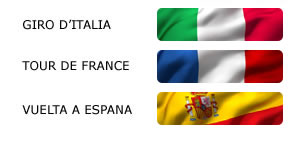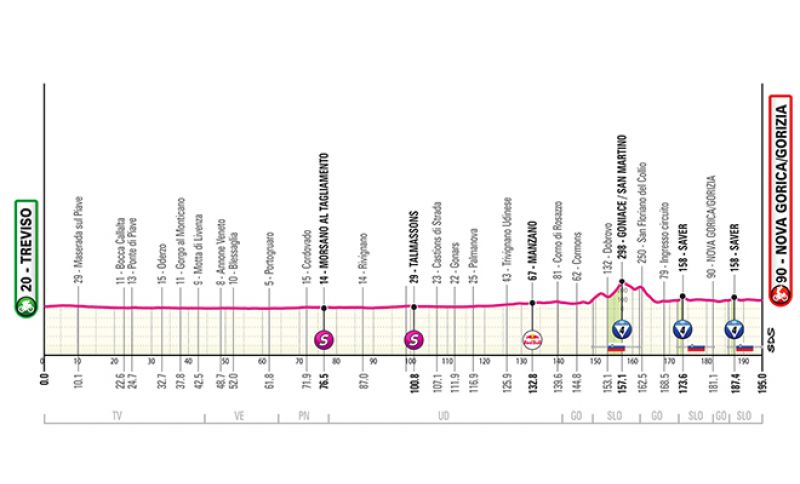

The fourteenth stage of the Giro d'Italia will take the peloton from Treviso to Nova Gorica / Gorizia for 195 km. This is a completely flat stage characterized by some short climbs at the end.
to follow the live coverage of the entire stage starting at 12:45 CLICK HERE
The route crosses the low Venetian plains, entering the Friulian plains after Cordovado and the Tagliamento river. At km 140, the route enters Slovenia for the first time with some brief climbs in the Collio (Brda) to reach Gorizia and enter the final circuit of about 14 km to be covered once after crossing the finish line (in Nova Gorica, Slovenia). The stage follows predominantly straight roads with varying width, interspersed with inhabited centers with typical traffic obstacles. After the short climb of Saver, the final kilometers are completely flat.
THE TERRITORY. The altimetry of the fourteenth Giro stage invites speed. A temptation that those following the race must resist, as there are many stops to appreciate along the road connecting Treviso to Gorizia.
Piazza dei Signori in Treviso is the best starting point of the day. Here are the three most important buildings in the city: Palazzo dei Trecento, the Civic Tower, and the 15th-century Palazzo del Podestà. Then reach the Romanesque Cathedral, walking under the arcades of Via Calmaggiore, the authentic backbone of the city, before moving along the banks of the Sile River, whose flow characterizes the city's design.
Leaving Treviso, you enter the lands of Venetian furniture makers. We are in the heart of the Treviso Wood Furniture District, which also includes Oderzo, where you can be amazed by splendid mosaics from the Roman era and the imposing Cathedral dedicated to Saint John the Baptist. Shortly after, you enter Portogruaro, a suggestive water city. It's the Lemene River flowing through the center that accompanies you on a walk with an ancient flavor among buildings that testify to the importance of the place over the centuries. First among these is the Municipal Palace, in Gothic style with Ghibelline merlons, but no less impressive are the Venetian-style palazzos overlooking Corso Martiri della Libertà.
A perfect star drawn in the green of the Friulian countryside. This is the shape of Palmanova, the fortress city built by the Venetians at the end of the 16th century. A military DNA that can be found in Piazza Grande, the ancient parade ground with a hexagonal shape, overlooked by important civil buildings, the 17th-century Cathedral, and the Civic Historical Museum. The extraordinary Friulian walled city, not by chance on the UNESCO World Heritage list, is the ideal gateway to the eastern Friulian hill area.
The race route first leads to Manzano, an important production center of the Chair District. Then it makes its way through vineyards to reach the Rosazzo Abbey, where as early as the 14th century, Benedictine monks were producing a renowned Ribolla Gialla wine. The route continues among rows and cellars of Collio until Cormons and from there to San Floriano del Collio, where orchards, particularly cherry trees, accompany the vineyards. The Giro passes through them in the perfect season, let's take advantage of it.
Finally, here are Nova Gorica and Gorizia, the cross-border cultural capitals of 2025. In reality, it's a single city, now almost only virtually divided (at least in terms of freedom of movement and exchange) by the Italian-Slovenian border. Nova Gorica is an ideal starting point for exploring the rich cultural and natural heritage of the region. Among its main attractions are the Kostanjevica Monastery, which houses the tomb of the last King of France Charles X, the Solkan Bridge, famous for its record stone arch, and Mount Sabotino, once a battlefield, now transformed into a Peace Park, where you can visit World War I trenches and enjoy spectacular views of the Isonzo Valley.
